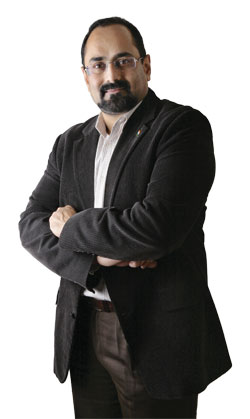
Hand-picked by Vinod Dham—the father of the Pentium chip—to work at Intel after his graduation from IIT, Rajeev Chandrasekhar (M.S. CS ’88) says he had something besides drive, perspective, and a contrarian streak to jumpstart his success as a chip architect, telecom pioneer, and venture capitalist.
“I was where I was when I was,” he says via telephone from India, where he is serving his second term as an independent member in the upper house of India’s Parliament, representing Bangalore and the state of Karnataka. “It’s fate and a bit of a blessing to be where you are when you are. I found myself a little ahead of the curve and in places where people hadn’t yet reached.”
Chandrasekhar was a member of the architecture teams that invented the 486 chip and later, Intel’s signature Pentium chip. He recalls that co-founder Andy Grove often stood at Intel’s main entrance clocking employees and that it was common to see Bill Gates, Steve Jobs, or Larry Ellison in the company cafeteria sharing doughnuts and discussion. It was a time when many people believed computing was reserved for helping businesses improve productivity and calculating the bottom line—not for households or personal communication.
“But I felt like a participant and witness to the building of a new world, one that we now live in and kind of take for granted,” he says. Chandrasekhar’s initials appear on every 486 processor ever manufactured, and one of his treasured keepsakes is the first 486 fabricated chip that went into production, signed by all members of his design group.
Infused with an entrepreneurial spirit from his time at Intel, Chandrasekhar returned to India in 1991. He got married and joined his father-in-law’s company, BPL Group, and hoped to expand its reach by investing in the country’s fledgling private telecom sector. He admits he was totally naïve about the industry and remained steadfast in the face of naysayers who proclaimed mobile phones “complete nonsense” and a luxury reserved only for India’s rich. By 2001, BPL Mobile was one of the largest cellular operators in India.
Facing increasingly restrictive regulatory challenges, Chandrasekhar says he simply didn’t wish to run a business anymore and sold the holding company, BPL Communications, four years later for $1.2 billion. He used some of the proceeds to take what he saw as the next logical step for an admitted risk-taker: the founding of Jupiter Capital, a venture development, management, and investment company.
“Jupiter has a fairly significant technology portfolio but not in the usual areas, such as Indian information technology or the Internet,” he says. “We instead select areas that are high-value and niche-oriented, such as aerospace and space aviation technology, that require significant amounts of specialized competency and knowledge. We pick markets where we believe people haven’t yet spotted the opportunity and we therefore create the opportunity ourselves.”
Chandrasekhar may claim to be a “full-time bluesman at heart,” with a framed gold album by his hero, the late Texas blues guitarist Stevie Ray Vaughan, hanging on the wall of his parliamentary office. But his political persona seems to be defined by the brash rapper Eminem—whose song lyrics provide him with a favorite motto, “I am not afraid to take a stand.” It is tempered, however, by the influence of his father, a career Indian Air Force pilot, who imbued in his son a service mindset. Chandrasekhar’s dark eyes can appear steely when posing any of the more than 700 questions he has raised before Parliament and warm in a photo documenting his family’s role as foster caretakers of the animals of Bannerghatta National Park. His opinions, however, remain unchanged no matter what the political focus.
“My experiences in politics and public life have been very different from what the conventional wisdom is, that everybody is a crook and that nobody gives a fig about serving their communities, states, or the country,” he says, in his characteristic outspoken manner. “I’m out there and available to people, to challenge and to be challenged. You have to post with India’s youth to engage them in a debate—you have to excite them and be fresh. It’s no longer the top-down model of saying, “I’m a politician and know all of the answers and the solution, and you will just take it.”
Chandrasekhar says technology is becoming an equalizer, pressuring politicians to be more honest and accountable, and citizens more aware of their rights and abilities to enforce those rights. On his website, he regularly connects with citizens through Tweets and blogs about his key issues: Bangalore and Karnataka, governance reforms, the national security and welfare of armed forces personnel, and public assets and revenues. He sees this as being part of what makes relationships thrive and new opportunities emerge.
“We‘ve come pretty far as a nation,” he says of his homeland. “We have our problems, like any other country in the world today. But I’m quite enthused and happy. I wake up in the morning and am eager to get to work.”
More Online
Rajeev Chandrasekhar’s website: rajeev.in